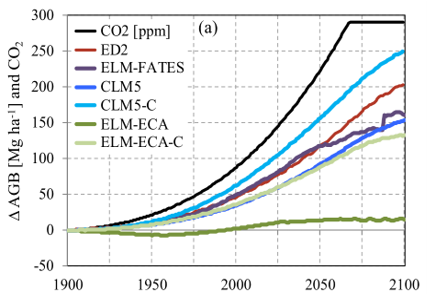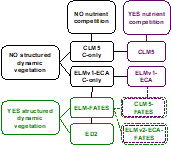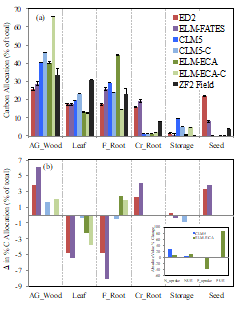The Science
The effects of rising atmospheric CO2 on tropical forests have been the focus of a large body of research, and the question of whether intact tropical forests will act as a large CO2 sink remains contested. Evidence supporting a sink, using pan-tropical inventory analyses, has suggested that the Earth’s intact tropical forests sequester roughly half of the global net terrestrial sink. However, more recent studies show these biomass sinks to be overestimated, or no increased forest productivity with rising CO2. An additional research need is to directly compare predictions between two terrestrial modeling approaches that are at the forefront of earth system modeling, which differ in vegetation structure competitive processes (i.e. ‘big-leaf’ models and Vegetation Demographic Models (VDMs)).
The Impact
With a doubling of CO2, three of the four models used here predicted an appreciable biomass sink (0.77 to 1.24 Mg ha-1 yr-1). ELMv1-ECA, the only model that includes phosphorus constraints, predicted the lowest biomass sink relative to initial biomass stocks (+21%), lower than the other biogeochemical (BGC) model, CLM5 (+48%). Model projections differed primarily through variations in nutrient constraints, then carbon allocation, initial biomass, and density- dependent mortality. The VDM’s performance (ELM-FATES and ED2) was similar or better than the BGC models run in carbon-only mode, suggesting that nutrient competition in VDMs will improve predictions. We demonstrate that VDMs are comparable to non-demographic (i.e.,‘big-leaf’) models, but also include finer-scale demography and competition that can be evaluated against field observations.
These VDMs were designed to operate at the ESM scale, but have never been fully tested for this application. This study takes a step at showing the potential advantages of coupling FATES to an ESM’s land surface model by comparing ED2 with ELM-FATES, which displayed a more realistically constrained absolute biomass sink, net primary productivity (NPP) flux, mortality rates, and leaf area index (LAI) compared to ED2. We conclude that VDMs are applicable and fruitful at ESM scale (e.g., similarities or improved performance compared to unconstrained C-only big-leaf models), but more testing needs to be done over regional to global scales.
Summary
For this study we simulated an old-growth tropical forest using six versions of four terrestrial models differing in scale of vegetation structure, and representation of BGC cycling, all driven with CO2 forcing from the preindustrial period to 2100. The models were benchmarked against tree inventory and eddy covariance data from a Brazilian site for present-day predictions. A quasi-factorial design was used to test structured vegetation dynamics and plant competition for nutrients as two critical processes to tropical forest dynamics and CO2 fertilization responses (i.e., direct “CO2 effect” or β-response). In addition to results listed above, our results revealed that all models used here predicted positive vegetation growth that outpaced mortality for an intact Brazilian forest, leading to continual increases in present-day biomass accumulation. Interestingly, the field data indicated that a quarter of canopy trees didn’t grow over the 15-year period, and biomass change was near-neutral. The results found here and model testing will benefit both DOE’s E3SM Project and the NGEE-Tropics Project.



Figure 1. Projected biomass estimates to 2100 with doubling CO2, relative to pre-industrial values (1900). Annual biomass increment (Mg ha-1 yr-1) increasing by (from lowest to highest): 0.10, 0.66, 0.77, 0.80, 1.04, and 1.24.
Figure 2. Quasi-factorial design for model comparison.
Figure 3. (a) Average present day carbon allocation (% of total biomass allocation) across six plant components. (b) Difference in the % of carbon allocation between 20th century and 21st century means, after doubling CO2; shift in C allocation.
Contacts (BER PM): Dan Stover and Sally McFarlane, Daniel.Stover@science.doe.gov (301-903-0289) and Sally.McFarlane@science.doe.gov (301-903-0943)
PI Contact): Jeffrey Q. Chambers William J. Riley, Lawrence Berkeley National Lab, jchambers@lbl.gov, wjriley@lbl.gov
Funding
DE-AC02-05CH11231 as part of their Next Generation Ecosystem Experiment-Tropics (NGEE-Tropics) and the Energy Exascale Earth System (E3SM) Program, as well as Laboratory Directed Research and Development (LDRD) funding from Berkeley Lab, funded by the U.S. Department of Energy, Office of Science, Office of Biological and Environmental Research.
Publication
Holm, J. A., Knox, R. G., Zhu, Q., Fisher, R. A., Koven, C. D., Nogueira Lima, A. J., Riley, W. J., Longo, M., Negron-Juarez, R. I., Araujo, A. C. de., Kueppers, L. M., Moorcroft, P. R., Higuchi, N., Chambers, J. Q. ( 2020). The Central Amazon biomass sink under current and future atmospheric CO2: Predictions from big-leaf and demographic vegetation models. Journal of Geophysical Research: Biogeosciences, 125, e2019JG005500. https://doi.org/10.1029/2019JG005500.